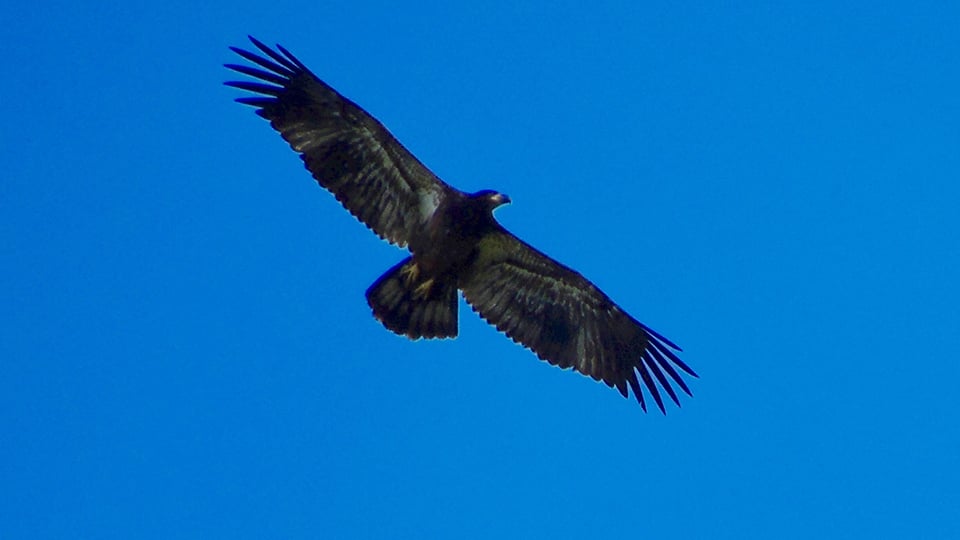 August 15, 2023: DH2 on a flyover
August 15, 2023: DH2 on a flyover
How high can a Bald Eagle fly? The topic came up when a moderator from another eagle group emailed me about a question related to the hurricane approaching Florida. Could an eagle fly to 50,000 feet to escape a hurricane? That’s a cool idea, but 50,000 feet translates to roughly 9.5 miles, and it’s generally believed that bald eagles don’t fly higher than about 20,000 feet above ground level. They aren’t going to escape a hurricane by flying above it, although they will hunker down to ride it out. I don’t know whether leaving ahead of a storm has ever been recorded in Bald Eagles (or any eagles), but it has been recorded in Golden-winged Warblers. Here’s a little more on birds and storm detection: https://www.raptorresource.org/2022/12/21/can-birds-detect-severe-weather-storms-cold-and-bald-eagles-in-winter/.
So how high can a bald eagle fly? Here’s what our data says…
Internet searches generally returned 20,000 feet as the upper limit for Bald Eagle flight, but I couldn’t find any supporting data in Brown’s Eagles Of The World or Stahlmaster’s The Bald Eagle. What was this commonly-known fact based on? Citations were lacking.
Although Bald and Golden Eagles aren’t very closely related, they are very similar in shape, size, and weight, and we’re tracking Golden Eagles right now. I decided to comb through 27,546 data points for Golden Eagle 833 between March 13th and May 2nd of this year. What would 833’s data tell us?
On his wintering grounds, 833 generally flew within a thousand to 1,500 feet of the ground. His altitude and overall movements started to tick up before he left for migration on April 25th, reaching an average of 1,830 feet above ground level (AGL) on April 23rd, and 2,001 feet AGL on April 24th. Between April 25th and April 27th, eagle 833 migrated 368 miles northwest, reaching a maximum height of 3.6 miles/19,000 feet AGL on April 26 and averaging nearly a mile AGL throughout the day: much higher than was typical on his wintering grounds. At 42 miles per hour, 833’s average speed wasn’t especially fast, but it was a steady sky-eating pace that added up over time.
While we picture Bald and Golden Eagles soaring high above the ground, it doesn’t make sense for them to fly extremely high most of the time: altitude takes energy and there isn’t much up there to eat. But wind at high altitude is usually faster and steadier than ground-level wind, which makes it perfect for migrating birds. Brown points out that eagles might also seek height for performative flying and perhaps enjoyment, which he refers to as ‘no obvious reason‘. Based on 833’s data, it appears that 20,000 feet above ground level is roughly the upper limit for Bald and Golden Eagle flight, although eagles appear to reserve most extreme high-altitude flight for long-distance migration.
What was 833’s fastest speed?
Brown estimates that a Golden Eagle can achieve 180 miles an hour in a vertical dive, while Brown and Amadon put their speed at between 150 and 198 miles per hour. 833 didn’t hit those speeds, but he did clock an incredible 103 miles per hour during a dive on April 15 that lowered his altitude about 381 feet in 10 seconds. That would have been something to see!
Could an eagle survive at 50,000 feet?
I suppose an eagle could be blown to 50,000 feet in a storm if it was unlucky enough to be caught in a strong updraft, but I don’t know if it would survive. There isn’t much oxygen, the air is very thin (NASA labels it a ‘space equivalent zone’), and an eagle’s body can only go so fast without breaking. While it might seem counter-intuitive to hunker down during a powerful storm, it would probably be safer than flying. Good luck to everyone, including eagles, in the path of the storm.
 The Raptor Resource Project
The Raptor Resource Project The Raptor Resource Project
The Raptor Resource Project